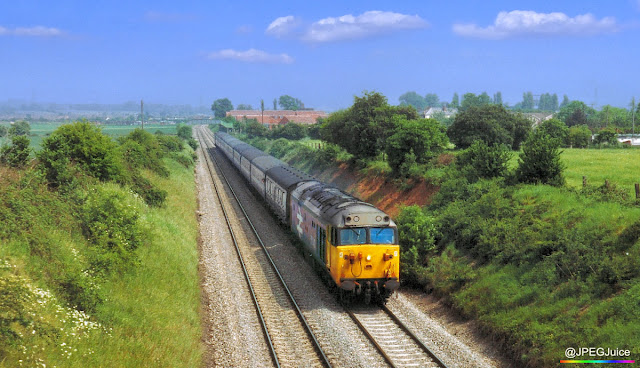Showing posts with label 1980s. Show all posts
Showing posts with label 1980s. Show all posts
Info-Pictorial: East Midlands Ranger in the ‘Deltic’ Era
"For the final period of ‘Deltic’ operation, starting on 5th October 1981, there were five ‘Deltic’ diagrams left, covering fifteen passenger trains on a weekday."

The primary focus of many an East Midlands Ranger ticket-holder in the 1979 to 1981 period: English Electric's Class 55 'Deltic' diesel. This is 55014 'The Duke of Wellington's Regiment' at Doncaster, on Sunday 26th July 1981.
It was one of the best value weekly area tickets of its time. At an average of less than a tenner between 1979 and 1981 (and less than a fiver for kids), the East Midlands Ranger presented a diesel haulage fanatic with an incredible opportunity to dive into the thick of ‘Deltic’ operation. Imagine that. A full week of intensive ‘Deltic’ haulage for less than a tenner. But that wasn’t all the East Mid offered. There was more. Much more…
1980s Pictorial: Diesels at Birmingham New Street
"At the start of the 1980s, Saltley drivers were not passed to drive the Class 50s, so all WR-bound services crewed from Saltley were forced to use a Midland compatible loco."

Remember when Birmingham New Street station acted as a relentless conveyor belt of loco-hauled trains, diesel mechanical units, and 'dinosaur' EMUs? When Rail blue still ruled supreme? Well, in this post I'm going to recall that era with a selection of diesel-focused photographs taken between 1980 and 1986. Without further ado, let's hand over to an archaic Praktica LTL, Pentax P30, and cheaper-than-cheap Prinz compact, for a timehop back to the glory days...
The Class 50 Refurbishment Story
"In response to a question by Modern Railways a few weeks later, BREL Managing Director Ian Gardiner argued that the 'super-overhaul' process could essentially be described as remanufacture..."

The archetypal look of the Class 50, post refurbishment. 50040 Leviathan heads for the South West, at Wychbold, in June 1982.
Believe it or not, it’s now a whacking 40 years since the hushed and experimental beginnings of the Class 50 refurbishment programme. For fans of the type, the scheme’s raft of modifications brought a buzz of excitement, with a new sound, a new look, and a drastic reduction in Class 47 stand-ins on ‘Hoover’ diagrams.
Indeed, it's fair to assume that the greater proportion of today's extant Fifties owe their very survival, in part, to BREL Doncaster’s four-year run of mega-overhauls which gutted and rebuilt every last member of the class. But for British Rail, the programme was part of a much wider quest to stem the rapidly diminishing reliability of the diesel fleet…
Time Tunnel: Publications For Train Spotters
"The appeal of these ‘underground’ publications would be lost on mainstream publishers. If the authors had not self-published, the books would never have seen the light of day."

These days, if we saw someone opening up a deck chair on a piece of waste ground next to a railway line, in mid winter, we’d probably assume they were a few sandwiches short of the full picnic basket. But in the 1970s, train spotters did exactly that, and no one batted an eyelid.
In the evening, your school teacher sat in a luggage trolley on Platform 10a at New Street station, with a pad and pen. Shine, rain or snow. Yes, once upon a time, people really were that dedicated to train spotting, and it was contagious. Platform ends got seriously overcrowded with spotters, all somehow trying to turn British Rail’s steps, parcel receptors and ramps into items of makeshift furniture. In the summer, some spotters would just sit, kneel or even lie on the concrete.
The UK’s railway was a very different place back then. Inherently more exciting than it can ever be in the high-tech, heavily standardised and altogether more reliable age of 2019. But spotters in the post-steam era would not have bustled so feverishly without the publishers. Train spotting books, and other published matter, set everything into context. Gave locomotives, and other vehicles, an identity. In this post, I’m taking a retrospective look at the publishing scene that glorified British Rail to the enthusiast in the 1970s and early 1980s.
